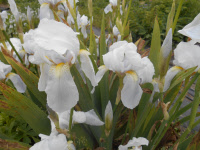Description
Sweetly fragrant, tall, icy blue-white iris with pale yellow signal on the fall, flowering in June
Sweetly fragrant, tall, icy blue-white iris with pale yellow signal on the fall, flowering in June
Sweetly fragrant, tall, icy blue-white iris with pale yellow signal on the fall, flowering in June
Clusters of crimson, star-shaped florets atop 2’ stems bloom their heads off ALL summer into fall.
Size: 24-36”x 12”
Care: Sun in well-drained alkaline soil, drought tolerant
Native: Mediterranean
Wildlife Value: attracts butterflies, bees and hover flies.
Centranthus is from the Greek meaning “spurred flower.” According to Culpepper, an English herbalist from the early 1600’s, this plant comforts the heart and stirs up lust. Parkinson, in 1629 describes it “of a fine red colour, very pleasant to behold.”
Balloon shaped buds as though puffed with air, open to white, five-petal bells from mid-summer to early fall.
Size: 24" x 12"
Care: Sun to part shade in moist well-drained soil, heat and drought tolerant. Deadhead for rebloom.
Native: Eastern Asia
Wildlife Value: attracts hummingbirds, bees & butterflies
Awards: England's Royal Horticultural Society Award of Garden Merit.
Platycodon is Greek from platys meaning “broad” and kodon meaning “bell”, referring to the shape of the flower. Cultivated in China for hundreds of years where it is called Jie-geng. The Chinese used the root boiled to cure a chill in the stomach. Mentioned in Man’yoshu, a Japanese anthology of poems written in the 8th century. German botanist Johann Gmelin first collected this in Siberia in 1754. Gmelin’s Siberian mission, sponsored by Catherine the Great, took 10 years and nearly killed him. Gmelin introduced it to European gardens by 1782. Robert Fortune found the white form in a nursery near Shanghai and sent it to England in 1845.
Dark pink-purple flowers from late spring to mid-summer
Size: 32” x 18”
Care: full sun to part shade in moist well-drained soil
Native: Europe
Wildlife Value: a favorite of Bumblebees
In Greek mythology Silene was a companion of Bacchus who was covered with foam. Dioicus means that male and female plants are separate. Described by 1750’s. Grown in American gardens since 1800’s
June – September (WOW!) short blue-purple, more blue than purple, spikes of compact flowers bloom on short, slowly creeping mat of sword-shaped foliage that suppresses weeds.
Size: 6-8” x 12”
Care: sun to part shade in well-drained soil
Native: Siberia, Mongolia & Kazakhstan
Wildlife Value: attracts pollinators. Drought tolerant; deer and rabbit resistant
According to Christian tradition, as Jesus carried the cross to Calvary, a woman wiped his face with her handkerchief, leaving the imprint of the features of his face, the vera iconica, meaning “true likeness.” When the Catholic Church canonized the woman, the Church gave her the name Saint Veronica. Medieval gardeners named a different Veronica after her due to the perceived likeness of the flower to her handkerchief. Collected by 1950 Russian botanist Nikolái Pávlov (1893-1971) described and named this in Vestn. Akad. Nauk Kazakhsk. S.S.R v.4 p. 92 (Academy of Sciences of the Kazakh SSR) in 1951. Kazakh is the name of the language of people of Central Asia inhabiting mainly Kazakhstan which became independent of Russia in 1991.


